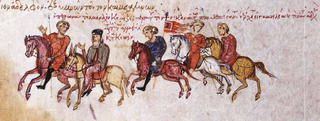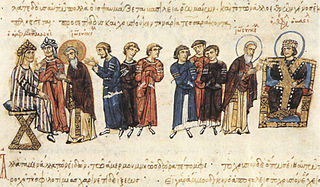
The Second Council of Nicaea is recognized as the last of the first seven ecumenical councils by the Eastern Orthodox Church and the Catholic Church. In addition, it is also recognized as such by the Old Catholics, and others. Protestant opinions on it are varied.

Michael III, also known as Michael the Drunkard, was Byzantine emperor from 842 to 867. Michael III was the third and traditionally last member of the Amorian dynasty. He was given the disparaging epithet the Drunkard by the hostile historians of the succeeding Macedonian dynasty, but modern historical research has rehabilitated his reputation to some extent, demonstrating the vital role his reign played in the resurgence of Byzantine power in the 9th century. He was also the youngest person to bear the imperial title, as well as the youngest to succeed as senior emperor.

Bardas was a Byzantine noble and high-ranking minister. As the brother of Empress Theodora, he rose to high office under Theophilos. Although sidelined after Theophilos's death by Theodora and Theoktistos, in 855 he engineered Theoktistos's murder and became the de facto regent for his nephew, Michael III. Rising to the rank of Caesar, he was the effective ruler of the Byzantine Empire for ten years, a period which saw military success, renewed diplomatic and missionary activity, and an intellectual revival that heralded the Macedonian Renaissance. He was assassinated in 866 at the instigation of Michael III's new favourite, Basil the Macedonian, who a year later would usurp the throne for himself and install his own dynasty on the Byzantine throne.

Theodora, sometimes called Theodora the Armenian or Theodora the Blessed, was Byzantine empress as the wife of Byzantine emperor Theophilos from 830 to 842 and regent for the couple's young son Michael III, after the death of Theophilos, from 842 to 856. She is sometimes counted as an empress regnant, exercising power in her own right, rather than just a regent. Theodora is most famous for bringing an end to the second Byzantine Iconoclasm (814–843), an act for which she is recognized as a saint in the Eastern Orthodox Church. Though her reign saw the loss of most of Sicily and failure to retake Crete, Theodora's foreign policy was otherwise highly successful; by 856, the Byzantine Empire had gained the upper hand over both the Bulgarian Empire and the Abbasid Caliphate, and the Slavic tribes in the Peloponnese had been forced to pay tribute, all without decreasing the imperial gold reserve.

Methodios I or Methodius I was Ecumenical Patriarch of Constantinople from March 4, 843 to June 14, 847. He was born in Syracuse and died in Constantinople. His feast day is celebrated on June 14 in both the East and the West.

Petronas was a notable Byzantine general and leading aristocrat during the mid-9th century. Petronas was a brother of Empress Theodora and hence brother-in-law of Emperor Theophilos, under whom he advanced to the high court rank of patrikios and the post of commander of the Vigla guard regiment. After Theophilos' death, he played a role in the ending of Iconoclasm, but was sidelined along with his brother Bardas during the minority of his nephew, Michael III, when power was held by the regent Theoktistos. In 855, Petronas and Bardas encouraged Michael III to seize control of the government: Theoktistos was murdered, Theodora banished to a monastery, Bardas became Michael's chief minister, and Petronas was tasked with the war against the Arabs. In 863, he scored a crushing victory at the Battle of Lalakaon, a feat which marked the gradual beginning of a Byzantine counter-offensive in the East. Promoted to the rank of magistros and the office of Domestic of the Schools, he died in 865.

Theoktistos or Theoctistus was a leading Byzantine official during the second quarter of the 9th century and the de facto head of the regency for the underage emperor Michael III from 842 until his dismissal and murder in 855. A eunuch courtier, he assisted in the ascent of Michael II to the throne in 820, and was rewarded with the titles of patrikios and later magistros. He held the high posts of chartoularios tou kanikleiou and logothetēs tou dromou under Michael and his son Theophilos. After Theophilos' death in 842, Theoktistos became a member of the regency council, but soon managed to sideline the other members and establish himself as the virtual ruler of the Empire. Noted for his administrative and political competence, Theoktistos played a major role in ending the Byzantine Iconoclasm, and fostered the ongoing renaissance in education within the Empire. He also continued the persecution of the Paulician sect, but had mixed success in the wars against the Arabs. When Michael III came of age in 855, his uncle Bardas persuaded him to throw off the tutelage of Theoktistos and his mother, the Empress-dowager Theodora, and on 20 November 855, Theoktistos was assassinated by Bardas and his followers.

Lazarus, surnamed Zographos, is a 9th-century Byzantine Christian saint. He is also known as Lazarus the Painter and Lazarus the Iconographer. Born in Armenia on November 17, 810, he lived before and during the second period of Byzantine Iconoclasm. Lazarus was the first saint to be canonized specifically as an iconographer. He was later followed by Saint Catherine of Bologna.

John VII, surnamed Grammatikos or Grammaticus, i.e., "the Grammarian", was Ecumenical Patriarch of Constantinople from January 21, 837 to March 4, 843, died before 867. He is not to be confused with the much earlier philosopher John Philoponos.

The Feast of Orthodoxy is celebrated on the first Sunday of Great Lent in the Eastern Orthodox Church and other churches using the Byzantine Rite to commemorate, originally, only the final defeat of iconoclasm on the first Sunday of Lent in 843, and later also opposition to all heterodoxy.

The Byzantine Iconoclasm were two periods in the history of the Byzantine Empire when the use of religious images or icons was opposed by religious and imperial authorities within the Ecumenical Patriarchate and the temporal imperial hierarchy. The First Iconoclasm, as it is sometimes called, occurred between about 726 and 787, while the Second Iconoclasm occurred between 814 and 842. According to the traditional view, Byzantine Iconoclasm was started by a ban on religious images promulgated by the Byzantine Emperor Leo III the Isaurian, and continued under his successors. It was accompanied by widespread destruction of religious images and persecution of supporters of the veneration of images. The Papacy remained firmly in support of the use of religious images throughout the period, and the whole episode widened the growing divergence between the Byzantine and Carolingian traditions in what was still a unified European Church, as well as facilitating the reduction or removal of Byzantine political control over parts of the Italian Peninsula.
Leo the Mathematician, the Grammarian or the Philosopher was a Byzantine philosopher and logician associated with the Macedonian Renaissance and the end of the Second Byzantine Iconoclasm. His only preserved writings are some notes contained in manuscripts of Plato's dialogues. He has been called a "true Renaissance man" and "the cleverest man in Byzantium in the 9th century". He was archbishop of Thessalonica and later became the head of the Magnaura School of philosophy in Constantinople, where he taught Aristotelian logic.
Manuel the Armenian, was a prominent Byzantine general of Armenian origin, active from c. 810 until his death. After reaching the highest military ranks, a palace conspiracy forced him to seek refuge in the Abbasid court in 829. He returned to Byzantine service the next year, receiving the position of Domestic of the Schools from Emperor Theophilos, who had married his niece Theodora. Manuel remained in the post throughout Theophilos's reign, and reportedly saved the emperor's life in the Battle of Anzen in 838. According to one report, he died on 27 July 838 of wounds received during the battle, but other sources record his survival past this date, ascribing him a major role in the regency that governed the empire after Theophilos's death, and report that he died some time around 860.
Sergios Niketiates was a senior Byzantine official and member of the Amorian dynasty. He is celebrated as a saint by the Eastern Orthodox Church on 28 June for his role in the restoration of the veneration of icons.

Saint Symeon Stylites of Lesbos (765/766–844) was a monk who survived two attempts on his life during the second period of Byzantine Iconoclasm (814–842). He followed a similar model to Simeon Stylites, residing on a pillar-like structure similar to a tower. There he isolated himself from the world and fasted, prayed and studied. In the Eastern Orthodox Church he is venerated as a saint, along with his two brothers: Saint George the Archbishop of Mytilene and Saint David the Monk.

The Icon of the Triumph of Orthodoxy is a divine celebratory icon created around 1400 to commemorate the first feast of the Triumph of Orthodoxy on the first Sunday of Great Lent. The icon references the overcoming of the Byzantine Empire’s Eastern Orthodox faith from the dominance of the Islamic faith and the Byzantine Iconoclasm in 842. Shown in the icon's composition are important figures such as the Virgin Hodegetria, her child Jesus, and eleven saints and martyrs associated with the Triumph of Orthodoxy. Other elements and saints depicted in the icon’s composition are representative of iconodule ideology and the turmoil endured. It is painted with mediums such as gold leaf and egg wash that are of divine spiritual significance.

Thekla, Latinized as Thecla, was a princess of the Amorian dynasty of the Byzantine Empire. The eldest child of Byzantine emperor Theophilos and empress Theodora, she was proclaimed augusta in the late 830s. After Theophilos's death in 842 and her mother becoming regent for Thekla's younger brother, Michael III, Thekla was associated with the regime as co-empress alongside Theodora and Michael.

Constantine was an infant prince of the Amorian dynasty who briefly ruled as co-emperor of the Byzantine Empire sometime in the 830s, alongside his father Theophilos. Most information about Constantine's short life and titular reign is unclear, although it is known that he was born sometime in the 820s or 830s and was installed as co-emperor soon after his birth. He died sometime before 836, possibly after falling into a palace cistern.

The Amorian dynasty ruled the Byzantine Empire from 820 to 867. The Amorian dynasty continued the policy of restored iconoclasm started by the previous non-dynastic emperor Leo V in 813, until its abolition by Empress Theodora with the help of Patriarch Methodios in 842. The continued iconoclasm further worsened relations between the East and the West, which were already bad following the papal coronations of a rival line of "Roman Emperors" beginning with Charlemagne in 800. Relations worsened even further during the so-called Photian Schism, when Pope Nicholas I challenged Photios' elevation to the patriarchate. However, the era also saw a revival in intellectual activity which was marked by the end of iconoclasm under Michael III, which contributed to the upcoming Macedonian Renaissance.
Anthony the Confessor was the archbishop of Thessalonica from 843 to his death. Most of his life is known through the vita of his relative Theodora of Thessalonica and he is venerated like her by the Eastern Orthodox Church on 2 November.














